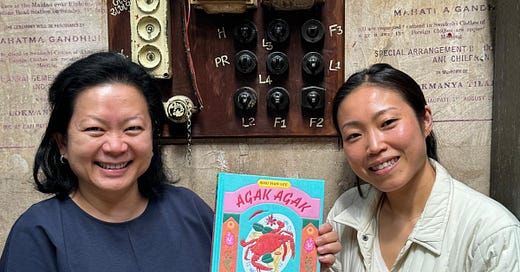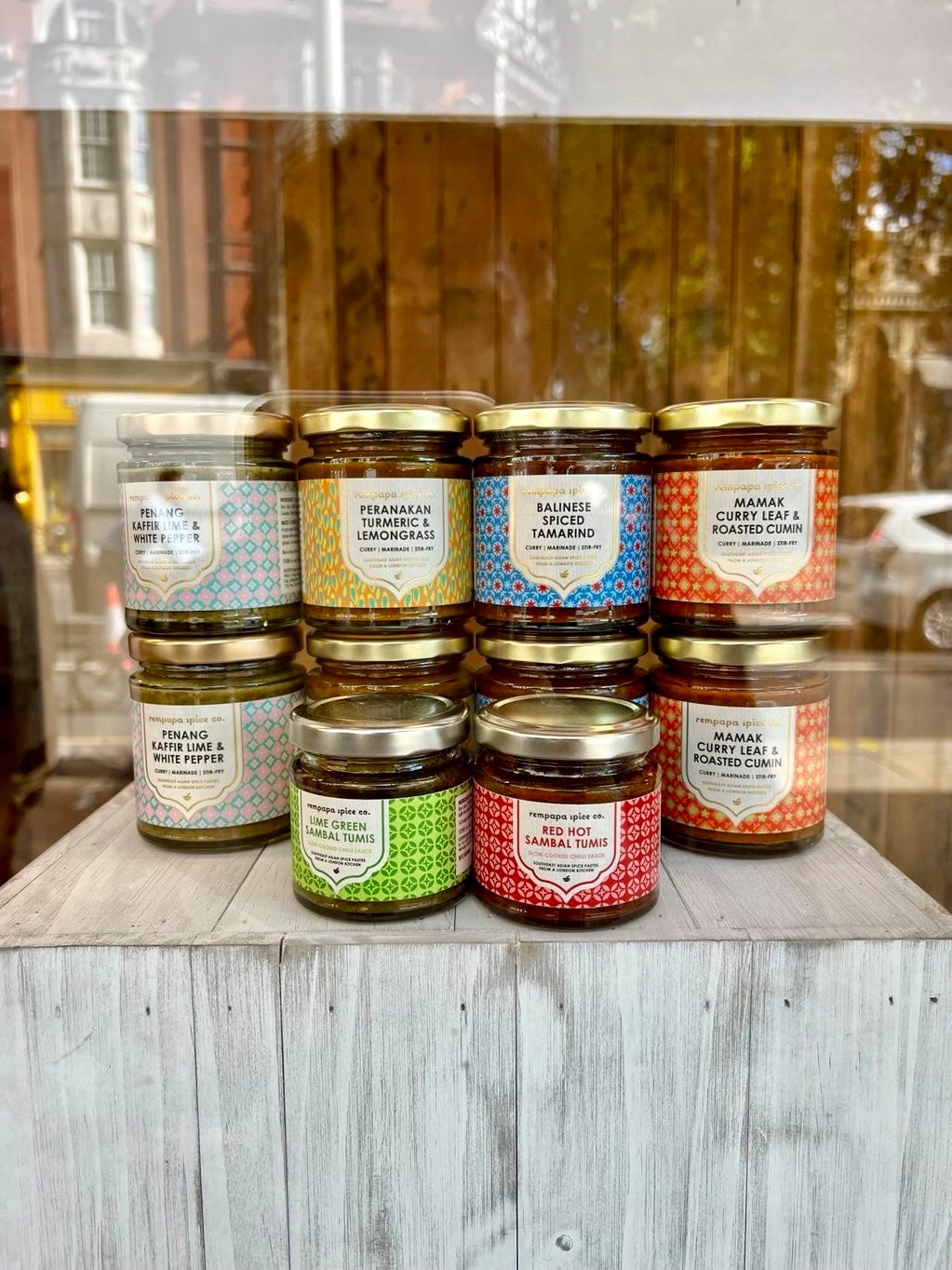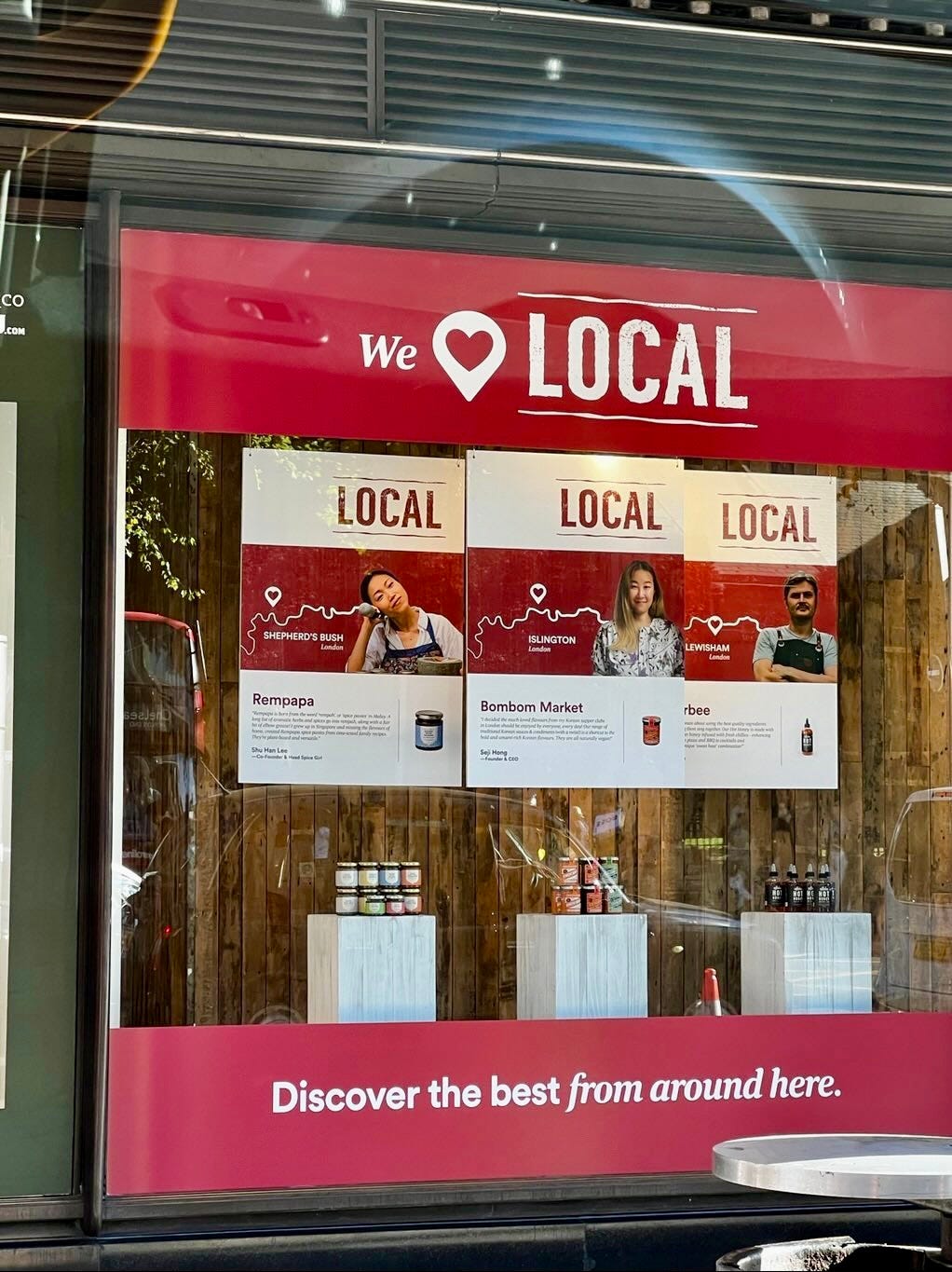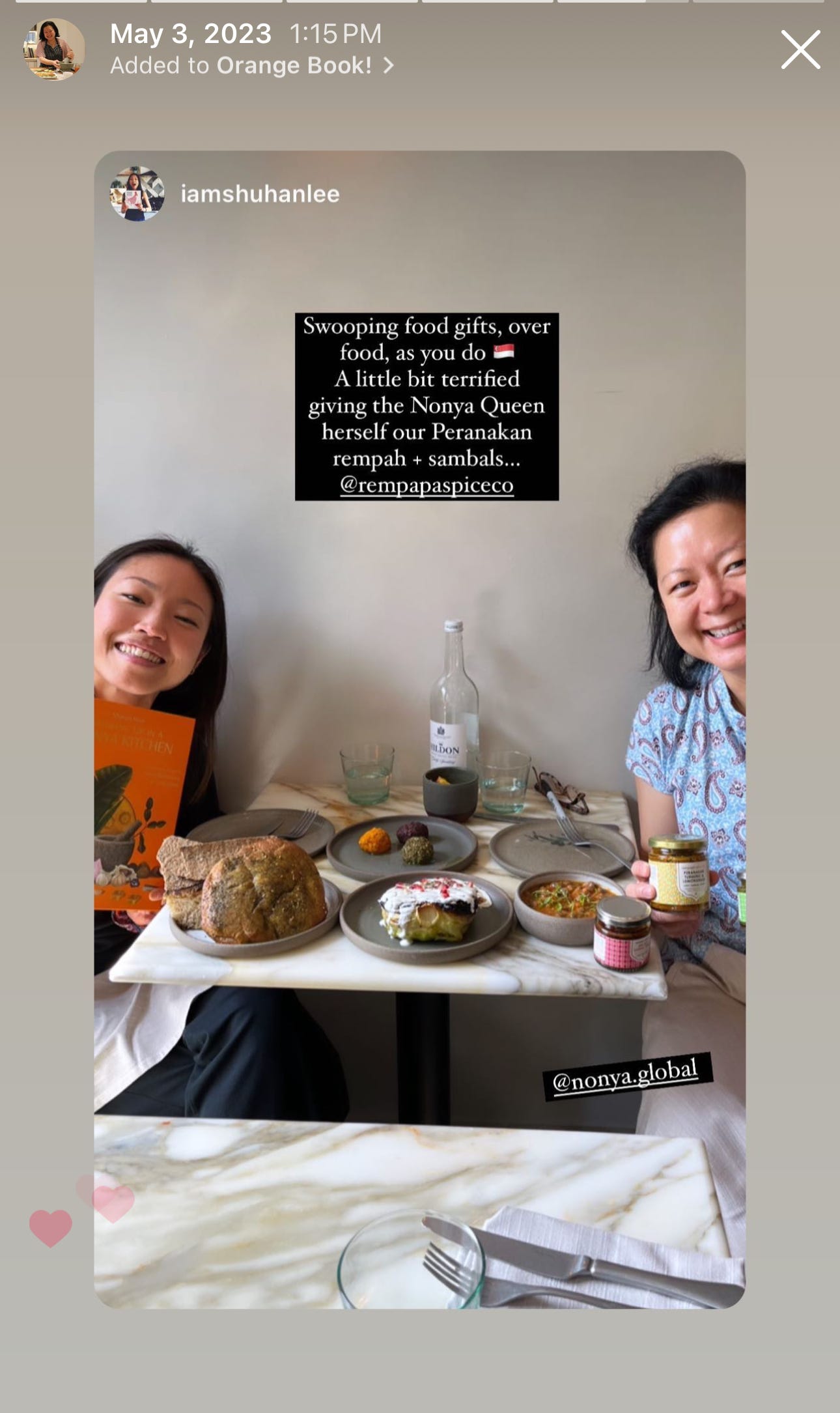My visits to London have now taken a new spin. I am fortunate to befriend talented food writers and entrepreneurs. Shu Han Lee embodies both. Born and raised in Singapore, she went to university in London and has since carved a career centered on food from HOME. Our home. We share that in common and I am so proud of Shu’s efforts to promote and broaden the appeal of Singapore’s multi-cultural cuisine in her humble, unassuming way, especially to the younger generation in ways that I might be too fuddy-duddy for. I would nominate Shu as the Millenial ambassador of Singapore food culture in the UK. And you will see what I mean when you get a copy of her new cookbook, “Agak Agak”.
It is a gorgeous book. Why? Shu is a designer with an intuitive flair for great graphics. Sincerity? She writes from her personal experiences and shares several family photos (“Every family member”) and shots of local food spots. Reliability? Loads because she tested every one of those recipes and has been cooking supper clubs with other homesick friends, which culminated in “Plus Six Five”, a cookbook cult classic documenting young Singaporean culture in London. Disciplined in how she completed her book (“Three times a week dedicated to writing, the rest to my business.”), Shu now invests most of her energy in growing her business “Rempapa” comprising delicious spicy sauces. A smart move she did was to add Coconut Milk to her product range.
I hope that this interview will resonate with many young readers (students in particular) who first relocate to this cherished cosmopolitan city, away from home and family, probably homesick to the core. It brims with hope that you too, will find your calling, your friends, settle in.. and that in this big world we live in, you can make another home for yourself in a new place and thrive well, like Shu.
You were born and raised in Singapore. Describe what it was like growing up in Singapore - your childhood memories of food, friends and family.
I grew up in a big family – two sisters, one brother. Our extended family was even larger – my father is the youngest of 11 siblings and my mother, the eldest of five. That meant it was always noisy and busy, and there was almost always food in the house, ‘just in case’. My mother is an incredible cook. I remember the house always smelling of food - fried garlic and/or steamed rice and/or one of her old-school charcoal-fired soups. We were spoilt with homecooked food almost every day, though we grumbled about it and relished the weekend treats of McDonald’s Happy Meals or roti prata from our favourite Indian stall. My father ran – still runs – a hardware shop in Jalan Besar so I also have fond memories of playing among coils of wire and lightbulbs as a child and then having kway chap or curry rice in the area.
As a ‘90s kid, I got to experience a lot of the exciting changes that Singapore went through, and the crazy food trends that overtook Singapore. I remember flying kites with my secondary schoolmates at Marina Bay when it was an open patch of grass, then going for dinner at one of the many steamboat restaurants flanking the grass fields. (And look at MBS* now!) I remember the excitement we had pretending to study while sipping frappuccino (with extra whipped cream) at Starbucks, queuing for pork floss buns and Taiwanese bubble tea, adding ma la to everything…
*MBS is Marina Bay Sands with its iconic three-building landmark linked by a sky bridge with pools, bars and restaurants, made more memorable in the “Crazy Rich Asians” movie.
When you moved to the UK, what did you miss most about Singapore? And how did you cope?
Given this is a very food-focused interview you might be surprised to hear that it wasn’t the food that I missed first/ most. It was the people back home. My first year at uni was hard - I often felt lonely and out of place and I took every opportunity to fly to Singapore. I learnt to cook to soothe and ground myself in a strange new city, and it gave me the excuse to Skype my mum for recipes. I still remember the first time I cooked rice in my shared uni halls. I had managed to both burn and undercook the rice at the same time, but while chewing on the dry hard grains, I felt a real sense of relief and accomplishment. So I kept cooking. I documented my kitchen adventures, both the good and the bad, on a blog. (Oh, the good old days of blogs!) Through the blog, I managed to meet a like-minded group of Singaporean friends. We would host monthly supperclubs at Goz’s cosy London flat, and it was through that, that I met yet more like-minded friends – this time from all over the world, but with a similar love and longing for the food and flavours of Singapore. It’s been 15 years since and when I look back on that first year, I feel very grateful for all that cooking has given me – not just a satisfied belly but friendships and opportunities I wouldn’t have been able to dream of.

What inspired you to create Rempapa Spice Co.? What have been the up’s and down’s of running this business?
In my supperclub days, I would make big batches of rempah and freeze any extras for quick midweek dinners, or even for effortless dinner parties. It’s a lot of effort to source, weigh and prepare ingredients, especially when it came to specialty ingredients such as lemongrass or galangal – so it made sense to do a bigger batch each time. Guests and friends would ask about buying these rempah packets. Together with my now-husband Olly, I took them to the local farmer’s markets and started selling them fresh every weekend. We didn’t start with much – a gazebo, table, blackboard and bags of optimism. It took years of slow, steady, hard work but Rempapa’s since grown to supply Whole Foods, Selfridges and lots of independent delis and farm shops across the UK.
It was a huge learning curve and in hindsight I would have started it after speaking to more business owners and securing funding. Because it started as a genuine side project, born purely out of love, I didn’t even think about the business fundamentals of making money from it! We had to learn everything through making mistakes – from product development (developing recipes for retail was very different to cookbooks!), to finance and accounting. For the first few years, I would take half days off work, head to a rented commercial kitchen with Olly to make rempah, drive the jars to our storage space at midnight, and then return to the agency at 8am for a pitch. It was not sustainable and it took a burn out – and a surprise listing by Whole Foods - for me to pluck up the courage to quit my job. I’m still learning every day and despite all the challenges, it’s been one of the most rewarding things I have done.
What inspired you to write the cookbook “Agak Agak”?
I actually wanted to write this book almost 10 years ago now, but my publishers then weren’t sure if Singaporean cuisine had a wide enough appeal. So it was a very happy, gratified “Yes” when Hardie Grant’s commissioning editor reached out and asked if I would like to write a Singaporean cookbook. It spoke to how far Singaporean food has come along in the past years and I’m so proud that word of our colourful, delicious food has spread far beyond our little island.
In a way, I’m glad to be writing this book later than I imagined, because I have come a long way as a cook and a writer. All the feedback that I’ve received from my supperclub guests, my Rempapa customers, and the readers of my earlier cookbook have helped to shape me into a better cookery writer. I’ve learnt what sort of recipes people love to cook most, and how I can make the process simpler but still delicious. I’ve learnt what ingredients people struggle to get hold of, and together, we’ve discovered new shortcuts and/or replacements. I’ve also learnt, very naturally, to cook with the seasons as it just makes more sense to reach for what’s most fresh and accessible on the shelves through the year.
So, I set out to write a Singaporean cookbook that wasn’t intimidating to someone new to our cuisine. I really wanted my readers to feel that they can achieve that easily in a home kitchen, even one that’s on the other side of the world.
Why “Agak Agak” then? (I did have a good chat with the brilliant Christopher Tan about the term, as I know it holds a lot of meaning!) While based on the Malay word for ‘somewhat’, ‘agak agak’ really comes to life in the home kitchen, where cooks are encouraged to rely on all their senses and experience, rather than tools or rigid formulas. It’s the way my mum, aunties and uncle cook - and it’s the way I’ve come to cook, especially here in the UK where I don’t always have the same ingredients to work with; nor the long hours to potter away.
The book is full of Singaporean recipes from my home kitchen - everyday recipes that I love and cook time and time again. There are the classics everyone will expect – laksa, satay, chicken rice – but I’ve tweaked and tested them so they’re simple enough for home cooks. There are also the lesser-seen, less ‘sexy’ dishes served only at home among friends and family like my mum’s steamed pumpkin rice. There are also recipes that I’ve come up with, whether for a supper club or dinner party, that combine the flavours I’ve grown up with the incredible fresh produce here. Throughout it all, there are tips and twists that encourage people to adjust, adapt and make it their own, to their taste. You can see now why “Agak Agak” really was such a fitting title!
Your parents still live in Singapore. How much of a role did they play in this cookbook?
There are a handful of recipes in the book that have come from my mother – her Steamed Pumpkin Rice, Tau Yew Bak (Braised Pork in Soy Sauce) and Ngoh Hiang (Five-Spiced) meatballs. The latter is something I have not seen outside of my family… my mum would fashion the leftover filling for ngoh hiang into crude meatballs, fry them, and give them to us warm as snacks so we would leave the main rolls alone until guests arrive. Here in the UK, where it’s hard to get hold of beancurd sheets, I turn to this less fiddly version. My father cannot cook and has never tried. Haha! But he loves eating and often takes us around Singapore in search of good food. He was a patient tour guide/ chauffeur/ taste tester during my cookbook research in Singapore.
What are your three favourite colours and why?
I love contrasts of colours and I have favourite colour pairings rather than favourite colours. These apply to design and to food:
Pink and yellow. (Think pickled red onion on a turmeric curry)
Red and green. (Think chilli padi on fresh leafy greens)
Orange and blue. (Think spiced ayam goreng on nasi kerabu)
Given your background in graphic design, describe your aesthetics in fashion and at home.
An old housemate years ago commented on my wardrobe once, saying they were ‘carpet colours’ – lovely boring shades of brown, beige and black. Since then, I have made a strong effort to embrace more colours in what I wear and in my home. I love collecting interesting plastes and bowls wherever I go, and I gravitate towards anything colourful - the pretty pastels of traditional Peranakan crockery and retro colourful enamels. I also think a lot about colours when I cook and when I plate a dish. Many of the most delicious dishes can look very… brown. Nothing wrong with that! But we do eat with our eyes as well, so I like to add a pop of red from sliced chillies or greenery from fresh herbs.
If you could concoct a new Singaporean hawker dish, what ingredients would go in it?
I love the almost outrageous mix of flavours, ingredients and influences that tze char chefs do so well! So, taking inspiration from them:
Eggs scrambled Cantonese style, with butter, sambal and curry leaves







